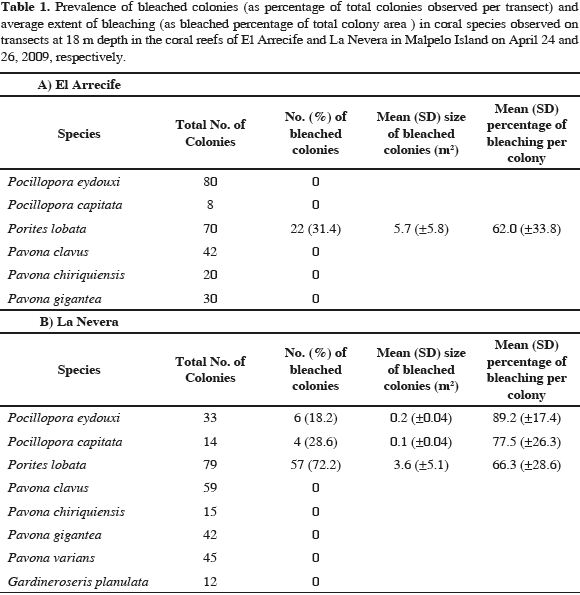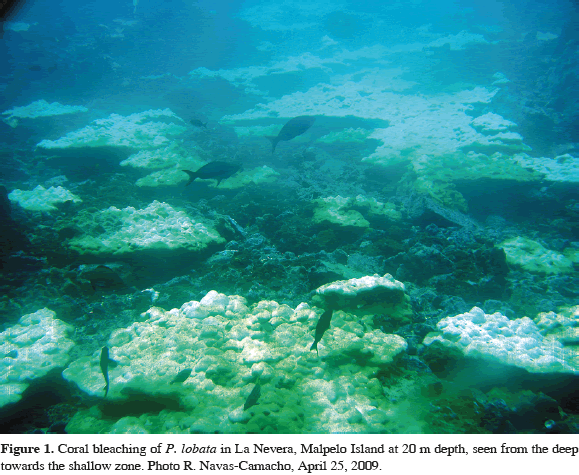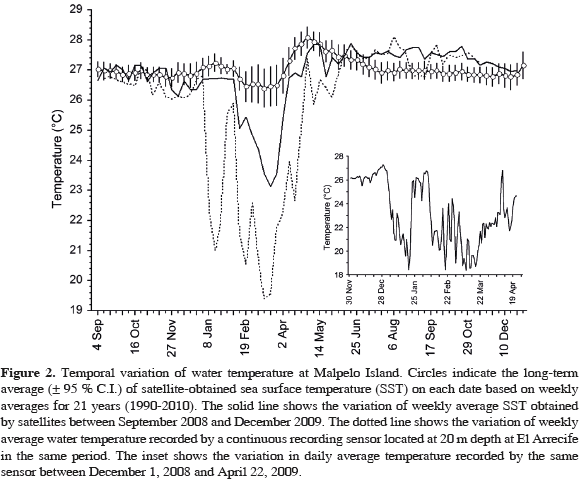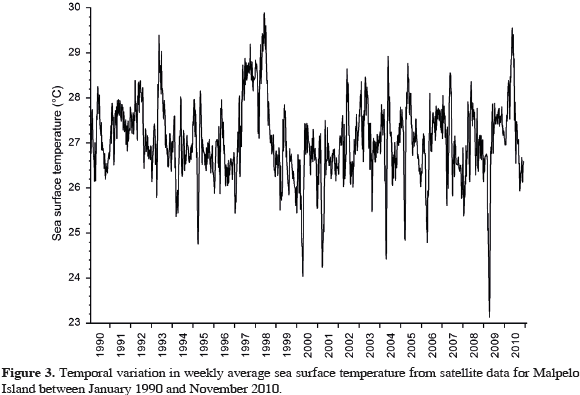Services on Demand
Journal
Article
Indicators
-
 Cited by SciELO
Cited by SciELO -
 Access statistics
Access statistics
Related links
-
 Cited by Google
Cited by Google -
 Similars in
SciELO
Similars in
SciELO -
 Similars in Google
Similars in Google
Share
Boletín de Investigaciones Marinas y Costeras - INVEMAR
Print version ISSN 0122-9761
Bol. Invest. Mar. Cost. vol.40 supl.1 Santa Marta Dec. 2011
NOTE:
EXTENSIVE BLEACHING OF THE CORAL PORITES LOBATA AT MALPELO ISLAND, COLOMBIA, DURING A COLD WATER EPISODE IN 2009*
EXTENSO BLANQUEAMIENTO DEL CORAL PORITES LOBATA EN LA ISLA MALPELO, COLOMBIA, DURANTE UN EPISODIO DE AGUAS FRÍAS EN 2009
Fernando A. Zapata1, Juliana Jaramillo-González1 and Raúl Navas-Camacho2
1 Universidad del Valle, Departamento de Biología, Grupo de Investigación en Ecología de Arrecifes Coralinos, Apartado Aéreo 25360, Cali, Colombia. fernando.zapata@correounivalle.edu.co (F.A.Z.), julijaramillo@gmail.com (J.J.G.).
2 Instituto de Investigaciones Marinas y Costeras-INVEMAR, Sistema Nacional de Monitoreo de Arrecifes Coralinos, Programa de Investigaciones Biodiversidad y Ecosistemas Marinos, Cerro Punta Betín, Apartado Aéreo 1016, Santa Marta, Colombia. rnavas@invemar.org.co.
RESUMEN
El blanqueamiento coralino es asociado frecuentemente con temperaturas inusualmente cálidas, pero también puede ocurrir durante episodios de enfriamiento del agua. En esta nota registramos un evento de blanqueamiento coralino, especialmente en Porites lobata, después de las temperaturas del mar más bajas registradas para Malpelo en 21 años. En abril de 2009 observamos blanqueamiento en cuatro de las diez especies coralinas registradas en la isla Malpelo. Este evento fue más frecuente (hasta el 72 % de las colonias) y extenso (hasta el 87 % del área de la colonia) en P. lobata. La temperatura superficial del mar obtenida por satélites alcanzó valores tan inusualmente bajos como 23.1 °C en marzo de 2009 con anomalías térmicas hasta de -4.4 °C. Un sensor de temperatura instalado a 20 m de profundidad indicó que la temperatura fue altamente variable durante el episodio frío disminuyendo hasta 15.8 °C en febrero de 2009. Una conjunción de la temporada de bajas temperaturas, condiciones similares a las de La Niña y otros factores no identificados parecen haber causado un episodio de descenso extremo de la temperatura que provocó una respuesta de blanqueamiento en P. lobata, un coral sensible al enfriamiento del agua.
PALABRAS CLAVE: Blanqueamiento coralino, Isla Malpelo, Pacífico colombiano, Pacífico Este Tropical, Porites lobata.
Bleaching in zooxanthellate corals is the loss of some of their symbiotic algae or photosynthetic pigments as a generalized response to stress by diverse environmental factors (Hoegh-Guldberg, 1999; Baker et al., 2008; Lough and van Oppen, 2009). The occurrence of mass bleaching events has been associated most often with prolonged increases in water temperature (Glynn, 1993; Brown, 1997; Hoegh-Guldberg, 1999; Baker et al., 2008; Eakin et al., 2009), but localized bleaching events have also been documented during episodes of unusually low temperature (e.g., Glynn and D'Croz, 1990, Coles and Fadlallah, 1991; Hoegh- Guldberg et al., 2005). However, reports of bleaching events during cold episodes and, in general, studies about bleaching produced by low temperatures are scarce (Saxby et al., 2003). In this note, we report the occurrence of extensive coral bleaching at Malpelo Island (Colombian Pacific) in coincidence with an extreme decrease in water temperature in early 2009.
Malpelo Island (4°00'12" N, 81°36'26" W) is a rocky island of volcanic origin with an area of 1.2 km2 located 380 km from the nearest point on the Pacific coast of Colombia (López-Victoria and Rozo, 2006). Besides small, isolated patch reefs and scattered coral colonies along the rocky sublittoral, Malpelo Island has a small coral reef in its north-eastern sector known as El Arrecife and a coral community on its western sector at the site known as La Nevera (Zapata and Vargas-Angel, 2003). Among the ten species of corals found in Malpelo, Porites lobata (Dana, 1846) stands out for its abundance below 15 m at El Arrecife and its dominance in La Nevera, with colonies ranging from 0.5 to 3 m in diameter in both sites (Rodríguez-Ramírez et al., 2007).
Between April 23 and 28, 2009 we made a visit to Malpelo Island during which we observed extensive coral bleaching, particularly in P. lobata. To assess the prevalence and extent of coral bleaching we examined the corals in two 80 x 1 m transects, one at 18 m and the other at 20 m depth, in El Arrecife, and in two other 100 x 1 m transects at the same depths in La Nevera. In the transects at 18 m depth we examined all the coral colonies present and their condition; if bleaching was observed, we measured the maximum length and width of each colony (to estimate its size as the area of an ellipse) and visually estimated the percentage of the bleached area. In the transects made at 20 m depth we only examined in detail those colonies with evident bleaching. To examine if the bleaching event was due to abnormal water temperature conditions, we analyzed the weekly averages of sea surface temperature (SST) obtained by satellites between 1990 and 2010 (NOAANCEP NOMADS Meteorological Data Server, http://www.emc.ncep.noaa.gov/cmb/sst_analysis/, Reynolds et al., 2002), and temperature data recorded every 1.2 h between September 2008 and December 2009 by a continuous recording sensor installed in El Arrecife at 20 m depth.
Of a total of six species of corals found in El Arrecife at 18 m, only one (P. lobata) was bleached (Table 1). Although the prevalence of bleaching in P. lobata was 31.4 % of colonies, the percentage of bleaching per colony was on average 62.0 ± 33.8 % (Mean ± SD) at 18 m and 51.4 % (± 14.6) at 20 m depth. Due to the large size of the bleached colonies of P. lobata in El Arrecife (5.7 ± 5.8 m2), and the relatively high coverage by this species at this depth (~ 20%), the extent of bleaching on the entire reef was considerable. In La Nevera, the prevalence and extent of bleaching were higher than in El Arrecife (Figure 1): three out of eight species observed at 18 m showed bleaching (Table 1). Except for two species with low coverage (Pocillopora capitata and P. eydouxi with 18.2 % and 28.6 % of colonies bleached, respectively), bleaching occurred mainly in P. lobata (72.2 % of colonies), while the remaining five species were not affected. The extent of bleaching per colony of P. lobata averaged 66.3 % (± 28.6) at 18 m and 86.8 % (± 8.7) at 20 m. Additionally, Gardineroseris planulata showed bleaching at 20 m in La Nevera, albeit with very low prevalence and extent. Finally, although we did not sample in the shallow zone (<15 m), we observed a large number of bleached colonies in this area of La Nevera.
The analysis of the water temperature data suggests that the coral bleaching observed in April 2009 at Malpelo was caused by an unusual drop in temperature. SST data from satellites clearly showed that after the first week of February 2009 there was an abrupt temperature drop that reached the lowest values recorded in the last 21 years (23.1 °C) during the third week of March 2009 (Figures 2 and 3). Negative thermal anomalies relative to the long-term average (1990-2010) < -2 °C occurred during six consecutive weeks between February 25 and April 1, 2009, and reached -4.4 °C in the week of March 18, 2009. The sensor data from El Arrecife showed that at a depth of 20 m the decline of temperature began one month earlier than indicated by satellite SST data (Figure 2). Sensor data also showed that the cooling event was not a simple episode of low temperature but a series of sharp fluctuations in temperature between January and April 2009 (Figure 2, inset). During this period the average daily temperature fluctuated within a maximum range of 8.9 °C between December 29, 2008 (27.3 °C) and March 10, 2009 (18.4 °C). The absolute minimum temperatures recorded by the sensor were 16.1 °C (January 19, 2009), 15.8 °C (February 20, 2009), and 16.0 °C (March 10, 2009), but these were transient with durations < 3.5 h. Sharp fluctuations in temperature of short duration can be caused by tidal cycles and internal waves (Sheppard, 2009).
Low water temperatures between January and March of each year are a well-known feature of the seasonal pattern of variation in the oceanographic conditions of Panama Bight (Forsberg, 1969; Stevenson et al., 1970; D'Croz and Robertson, 1997). At Malpelo, this pattern is evident in the long-term averages of SST and the greater variation around the means between January and March than in the rest of the year (Figure 2). During this period, the Intertropical Convergence Zone migrates from ~8-10 °N to ~2 °N, and consequently the north-east trade winds blow more strongly over the bight, producing a cyclonic pattern of water circulation and cold water upwelling in the Gulf of Panama and the middle of the bight, with a consequent shallowing of the thermocline (Rodríguez-Rubio et al., 2003; Devis- Morales et al., 2008). In late 2008 and early 2009, the Oceanic Niño Index (ONI) showed thermal anomalies between -0.5 and -0.8 °C for four consecutive months. Had these anomalies been maintained for one more month, they would have been sufficient for a formal declaration of a La Niña cold event (http://www.cpc.noaa.gov/products/analysis_monitoring/ensostuff/ensoyears.shtml). Hence, there was an overlap between the annual cold season and the occurrence of thermal conditions similar to those presented during a La Niña event. However, the same coincidence during La Niña of 2007-2008, with values of the ONI between -0.6 and -1.4 °C for nine months did not produce a decrease in temperature of the magnitude seen in 2009 (Figure 3). Also, there were no reports of coral bleaching during La Niña of 2007-2008 in Malpelo (Navas-Camacho et al., 2010) or other coral areas of the Colombian Pacific (F.A. Zapata, Pers. Obs.). This suggests that some other unidentified factor may have influenced the unusual decline of temperature in 2009.
Corals are highly sensitive to short exposures near their lower limit of temperature tolerance (~18 °C, Coles and Fadlallah, 1991). Porites lobata is considered one of the most sensitive species to low temperature since it begins to die as early as 23 h after being continuously exposed to temperatures of 15 °C (Edmondson, 1928). While the relationship between low temperature and coral bleaching is known but little studied (Saxby et al.; 2003, Baker et al., 2008), cases of bleaching have been documented experimentally by exposing species such as Pocillopora damicornis, Montipora verrucosa, Fungia scutaria (Jokiel and Coles, 1977) and Montipora digitata (Saxby et al., 2003) for short periods (≤ 30 days) to temperatures near or below 15 °C. It has also been shown that, similar to high temperatures, low temperatures decrease photosynthetic efficiency and cause loss of zooxanthellae and changes in photosynthetic pigment concentration as a response to increased susceptibility of corals to photoinhibition with decreasing temperature (Saxby et al., 2003; Hoegh-Guldberg et al., 2005; LaJeunesse et al., 2007; Baker et al., 2008).
Natural bleaching events during cold episodes have been reported in other localities. In Saboga Island (Gulf of Panama) bleaching of 27.2 % of colonies was attributed to a decrease in temperature to 17 °C in March 1985 (Glynn and D'Croz, 1990). However, at this same island in 2000 the water temperature declined to ~15 °C and no evidence of coral bleaching was observed (Glynn et al., 2001). Unusual bleaching of Pocillopora spp. colonies occurred in the Gulf of California between April and May 2006, but the temperature was only slightly lower than normal and never less than 19 °C, so that bleaching may have been caused by high levels of solar radiation during unusual conditions of water clarity (LaJeunesse et al., 2007). An extensive coral bleaching event observed in the Capricorn-Bunker Islands, southern Great Barrier Reef, Australia, in the winter of 2003 was attributed to a combination of low air temperature (13.3 °C), low humidity and strong winds during a low tide aerial exposure (Hoegh-Gulberg et al., 2005).
In conclusion, although the evidence presented here is correlational, it strongly suggests that bleaching of P. lobata and other corals at Malpelo Island was caused by the sharp decline in temperature that occurred in early 2009. Although coral bleaching has received much attention in relation to temperature increases, a more complete understanding of this phenomenon requires a more comprehensive documentation of the thermal conditions in which it occurs, especially given the expectations of global climate change. We recommend that coral bleaching events during cold episodes be documented routinely.
ACKNOWLEDGMENTS
We thank the Special Administrative Unit of National Natural Parks for permissions, the Malpelo and other Marine Ecosystems Foundation for the opportunity and logistical support, and Conservation International, Fondo para la Acción Ambiental y la Niñez and the Walton Family Foundation for funds for research in the Sanctuary of Flora and Fauna Malpelo. We also thank the crew of the M/N María Patricia for their support in the field.
LITERATURE CITED
1 Baker, A. C, P. W. Glynn and B. Riegl. 2008. Climate change and coral reef bleaching: An ecological assessment of long-term impacts, recovery trends and future outlook. Estuar. Coast. Shelf Sci., 80: 435-471. [ Links ]
2 Brown, B. E. 1997. Coral bleaching: causes and consequences. Coral Reefs, 16 Suppl.: S129-S138. [ Links ]
3 Coles, S. L. and Y. H. Fadlallah. 1991. Reef coral survival and mortality at low temperatures in the Arabian Gulf: new species-specific lower temperature limits. Coral Reefs, 9: 231-237. [ Links ]
4 D'Croz, L. and D. R. Robertson. 1997. Coastal oceanographic conditions affecting coral reefs on both sides of the Isthmus of Panama. Proc. 8th Int. Coral Reef Symp., 2: 2053-2058. [ Links ]
5 Devis-Morales, A., W. Schneider, R. A. Montoya-Sánchez and E. Rodríguez-Rubio. 2008. Monsoonlike winds reverse oceanic circulation in the Panama Bight. Geophys. Res. Lett., 35:L20607, doi:10.1029/2008GL035172. [ Links ]
6 Eakin, C. M., J. M. Lough and S. F. Heron. 2009. Climate variability and change: monitoring data and evidence for increased coral bleaching stress: 41-67. In: Van Oppen, M. J. H. and J. M Lough (Eds.). Coral bleaching-patterns, processes, causes and consequences. Ecological Studies, Vol. 205, Springer-Verlag, Berlin. 178 p. [ Links ]
7 Edmondson, C. H. 1928. The ecology of a Hawaiian coral reef. Bull. Bernice P. Bishop Mus., 45: 1-64. [ Links ]
8 Forsbergh, E. D. 1969. On the climatology, oceanography and fisheries of the Panama Bight. Bull. Inter. Am. Trop. Tuna Comm., 14: 1-385. [ Links ]
9 Glynn, P. W. 1993. Coral reef bleaching: ecological perspectives. Coral Reefs, 12: 1-17. [ Links ]
10 Glynn, P. W. and L. D'Croz. 1990. Experimental evidence for high temperature stress as the cause of El Niño-coincident coral mortality. Coral Reefs, 8: 181-191. [ Links ]
11 Glynn, P. W., J. L. Maté, A. C. Baker and M. O. Calderón. 2001. Coral bleaching and mortality in Panama and Ecuador during the 1997-1998 El Niño-Southern Oscillation event: spatial/temporal patterns and comparison with the 1982-1983 event. Bull. Mar. Sci., 69: 79-109. [ Links ]
12 Hoegh-Guldberg, O. 1999. Climate change, coral bleaching and the future of the world's coral reefs. Mar. Freshwater Res., 50: 839-866. [ Links ]
13 Hoegh-Guldberg, O., M. Fine, W. Skirving, R. Johnstone, S. Dove and A. Strong. 2005. Coral bleaching following wintry weather. Limnol. Oceanogr., 50: 265-271. [ Links ]
14 Jokiel, P. L. and S. L. Coles. 1977. Effects of temperature on mortality and growth of Hawaiian reef corals. Mar. Biol., 43: 201-208. [ Links ]
15 LaJeunesse, T. C., H. Reyes-Bonilla and M. E. Warner. 2007. Spring "bleaching" among Pocillopora in the Sea of Cortez, Eastern Pacific. Coral Reefs, 26: 265-270. [ Links ]
16 López-Victoria, M. and D. Rozo. 2006. Model-based geomorphology of Malpelo Island and spatial distribution of breeding seabirds. Bol. Invest. Mar. Cost., 35: 111-131. [ Links ]
17 Lough, J. M. and M. J. H. van Oppen. 2009. Introduction: Coral Bleaching-Patterns, Processes, Causes and Consequences: 1-5. In: Van Oppen, M. J. H. and J. M Lough (Eds.). Coral bleaching-patterns, processes, causes and consequences. Ecological Studies, Vol. 205, Springer-Verlag, Berlin. 178 p. [ Links ]
18 Navas-Camacho, R., K. Gómez-Campo, J. C. Vega-Sequeda, T. López-Londoño, D. L. Duque, A. Abril and N. Bolaños. 2010. Estado de los arrecifes coralinos. 75-100. In: INVEMAR (Ed.). Informe del estado de los ambientes y recursos marinos y costeros en Colombia: Año 2009. Serie de Publicaciones Periódicas No. 8, Santa Marta. 319 p. [ Links ]
19 Reynolds, R. W., N. A. Rayner, T. M. Smith, D. C. Stokes and W. Wang. 2002. An improved in situ and satellite SST analysis for climate. J. Climate, 15: 1609-1625. [ Links ]
20 Rodríguez-Ramírez, A., R. Navas-Camacho, M. C. Reyes-Nivia, S. Bejarano-Chavarro and J. Garzón-Ferreira. 2007. Implementación del SIMAC en la isla de Malpelo. 97-112. In: DIMAR-CCCP y UAESPNN-DTSO (Eds.). Santuario de Fauna y Flora Malpelo: descubrimiento en marcha. Dirección General Marítima-Centro Control Contaminación del Pacífico y Unidad Administrativa Especial del Sistema de Parques Nacionales Naturales-Dirección Territorial Suroccidente. Ed. DIMAR, Serie Publicaciones Especiales CCCP Vol. 5, Bogotá. 142 p. [ Links ]
21 Rodríguez-Rubio, E., W. Schneider and R. Abarca del Río. 2003. On the seasonal circulation within the Panama Bight derived from satellite observations of wind, altimetry and sea surface temperature. Geophys. Res. Lett., 30: doi:10.1029/2002GL016794. [ Links ]
22 Saxby T., W. Denninson and O. Hoegh-Guldberg. 2003. Photosynthetic responses of the coral Montipora digitata to cold temperature stress. Mar. Ecol. Prog. Ser., 248: 85-97. [ Links ]
23 Sheppard, C. 2009. Large temperature plunges recorded by data loggers at different depths on an Indian Ocean atoll: comparison with satellite data and relevance to coral refuges. Coral Reefs, 28: 399-403. [ Links ]
24 Stevenson, M. R., O. Guillén and J. Santoro de Ycaza. 1970. Marine atlas of the Pacific coastal waters of South America. Univ. California Press, Berkeley. 23 p. [ Links ]
25 Zapata, F. A. and B. Vargas-Ángel. 2003. Corals and coral reefs of the Pacific coast of Colombia. 419-447. In: Cortés, J. (Ed). Latin America coral reefs. Elsevier Science B.V., Amsterdam. 497 p. [ Links ]
FECHA DE RECEPCIÓN: 17/01/2011 FECHA DE ACEPTACIÓN: 12/10/2011
*Contribución No. 1090 del Instituto de Investigaciones Marinas y Costeras-INVEMAR.

















